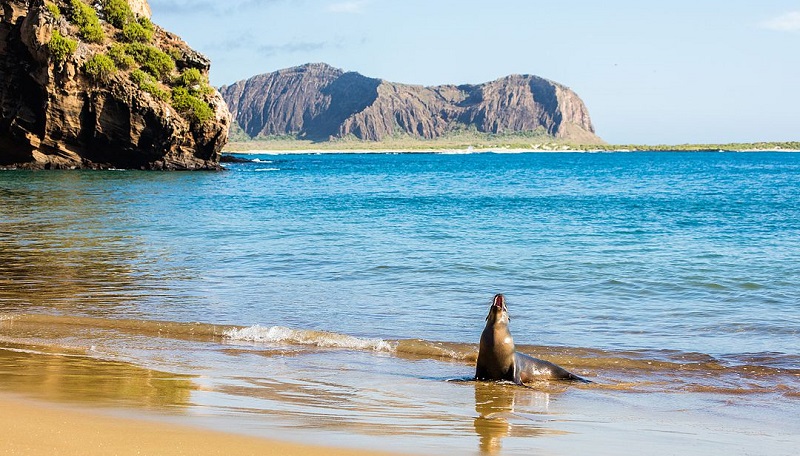Debt-for-nature and debt-for-climate swaps are becoming more common, with Ecuador’s recent $1.6bn deal the biggest yet. How do they work?
Government debts are rocketing to untenable levels while the need for huge investments in climate and nature becomes ever clearer.
Enter debt-for-climate and debt-for-nature swaps. Dating back to the 1980s, these measures are having a renaissance.
In the past, a common policy response to debt crisis was to boost exports by cutting down forests for timber or farmland. This was unsustainable.
In 1984, the World Wildlife Fund’s Thomas Lovejoy proposed debt-for-nature swaps as a solution and the US congress authorised the government to do them in 1990.
Recent moves
In 2018, the Seychelles announced it had converted $22 million of its debt into an obligation to spend that money protecting its oceans off the coast of East Africa.
In 2021, the Central American nation of Belize dodged International Monetary Fund austerity measures by swapping roughly $550m of its debt for an obligation to spend money saving its oceans.
In January, Portugal swapped the $152m Cape Verde owes it for a promise to invest $12m initially in an environmental fund. This will go towards climate measures like renewable energy production in its former colony.
Indonesia delays $20bn green plan, after split with rich nations on grants and new coal plants
Then in May came the biggest deal of them all. Ecuador changed $1.6 billion in debt into a commitment to spend at least $12 million a year on park rangers, drones and other measures to save the wildlife of the Galapagos islands.
Ecuadorean Foreign Minister Gustavo Manrique Miranda said biodiversity was now a valuable “currency”.
Andrew Johnstone is the CEO of an investment fund called Climate Fund Managers (CFM), which aims to protect the climate and nature and make a profit and was involved in the deal.
He said the swap was a “cutting-edge climate solution” that “sets a new precedent which we are actively looking to replicate across our focus markets of Africa, Asia and Latin America”.
US sparks controversy by backing oil company’s carbon-sucking plans
But how do these swaps really work? And are they as good as they sound? Let’s look at the example of Ecuador.
Who is letting Ecuador off their debts?
The institutions that Ecuador owed money to sold off $1.87 billion of that debt at a discount.
They didn’t do that out of charity. Debt is sold at a discount because it’s risky for lenders, who fear not getting paid back. This happens often and is not specific to Ecuador or to debt swaps.
Most of this debt, $1.63bn, was bought by pension funds, insurance companies and asset managers like Legal and General.
A smaller amount, $0.24bn was bought by CFM, through money that ultimately comes from mainly Northern European governments and from private companies like the BNG Bank and Aegon.
This $1.63bn debt was replaced with a new debt of just $0.66bn, called a “Blue Galapagos Bond”. With about $1bn of debt cancelled, Ecuador has a lot less to pay back every year.
Indonesia falls short on peatland restoration, risking destructive fire season
The government’s payments were further reduced when the US government’s International Development Finance Corporation (DFC) got involved.
It told CFM and the institutional investors lending the $0.66bn Blue Galapagos Bond to Ecuador that if the government doesn’t pay its debts, then it will pay them instead.
Lenders set their interest rate based on how they perceive the risk of lending.
With this guarantee, lending to Ecuador became less risky and, CFM say, lenders charged less interest than they had before – freeing up a load of money each year to spend on other things, like nature conservation.
Isn’t this a gamble for the DFC?
The DFC gets much of its initial money from the US government and ultimately taxpayers.
If Ecuador doesn’t pay its debts, it will lose out and have less money to invest in other projects like investments in health, food security and infrastructure.
Mainstream economists accused of playing down climate threat
Juan Paez is the Latin American head of Climate Fund Managers and was involved in the Ecuador deal.
He told Climate Home it was a gamble “but it’s a good gamble” because Ecuador is much less likely to default now the US has an interest in it not doing so.
“The political relationship between the US and Ecuador will allow the Americans with significant presence to influence, to help, to aid” to avoid a default, he said.
He said that when agencies like DFC provided political risk insurance, payouts “never really historically happened”.
Metals bosses enjoy front row seat at UN deep-sea mining negotiations
Paez was only aware of one exception in Latin America, when the World Bank’s insurance arm MIGA paid out for a claim in Argentina in 2004.
Why not just give Ecuador money for nature protection?
The US government has a limited aid budget and has to fight Congress for every penny.
With guarantees, they can get money to park rangers in the Galapagos without actually handing over a cent – unless Ecuador defaults on its debts.
“Its a much more effective use of capital,” said Paez, “based on basically a confidence in their balance sheet.”
Has there been any opposition to the deal?
Industrial fishing associations initially worried about the impact on their catch, but were assured the localised protections would boost fish populations in a wider area.
Civil society also has concerns. Latindadd, a coalition of Lati
Read More

